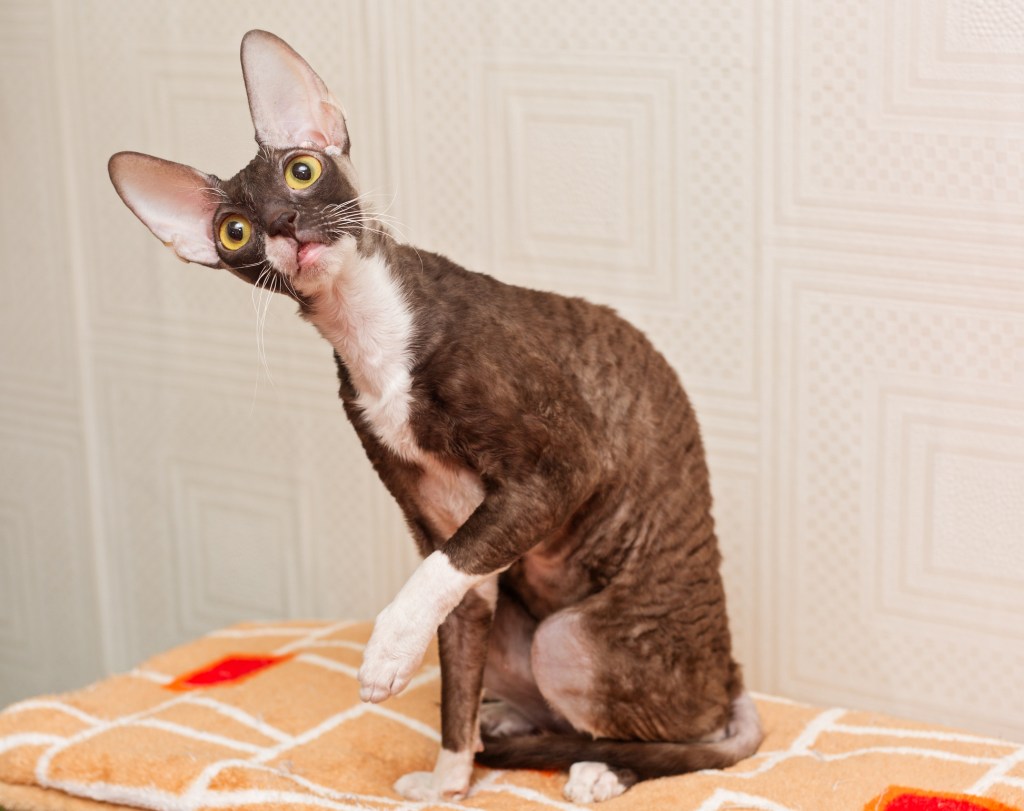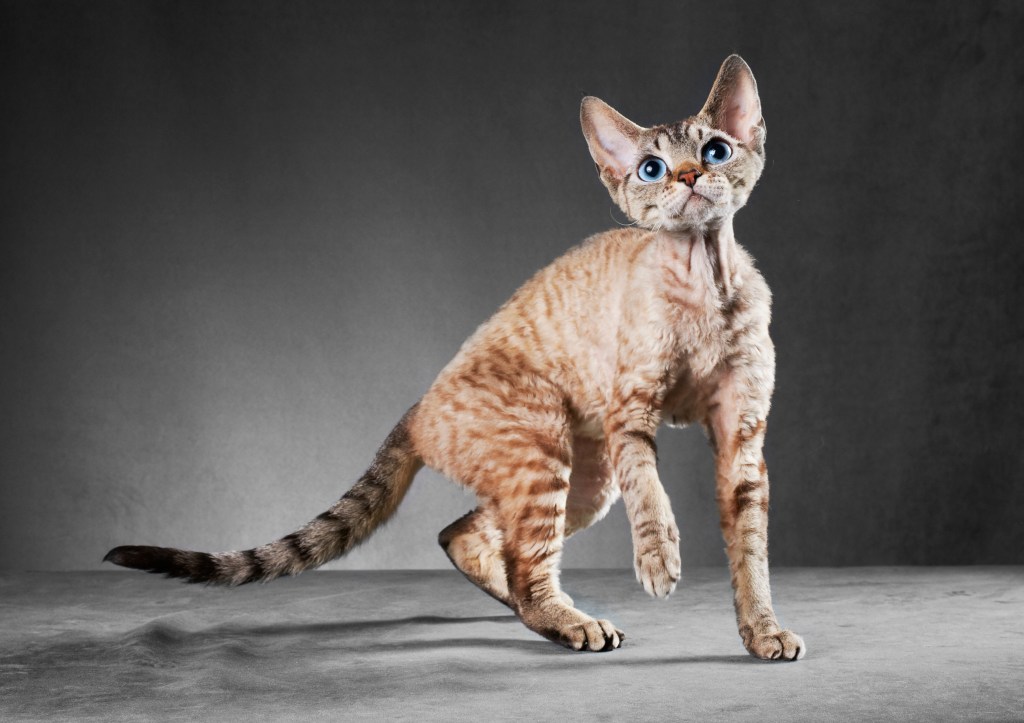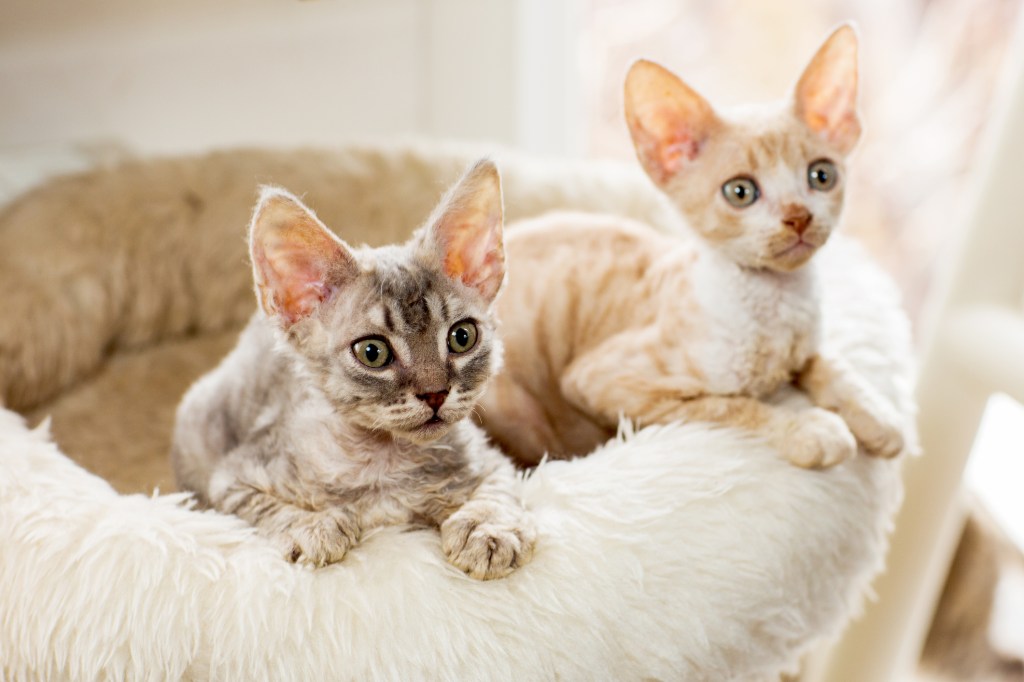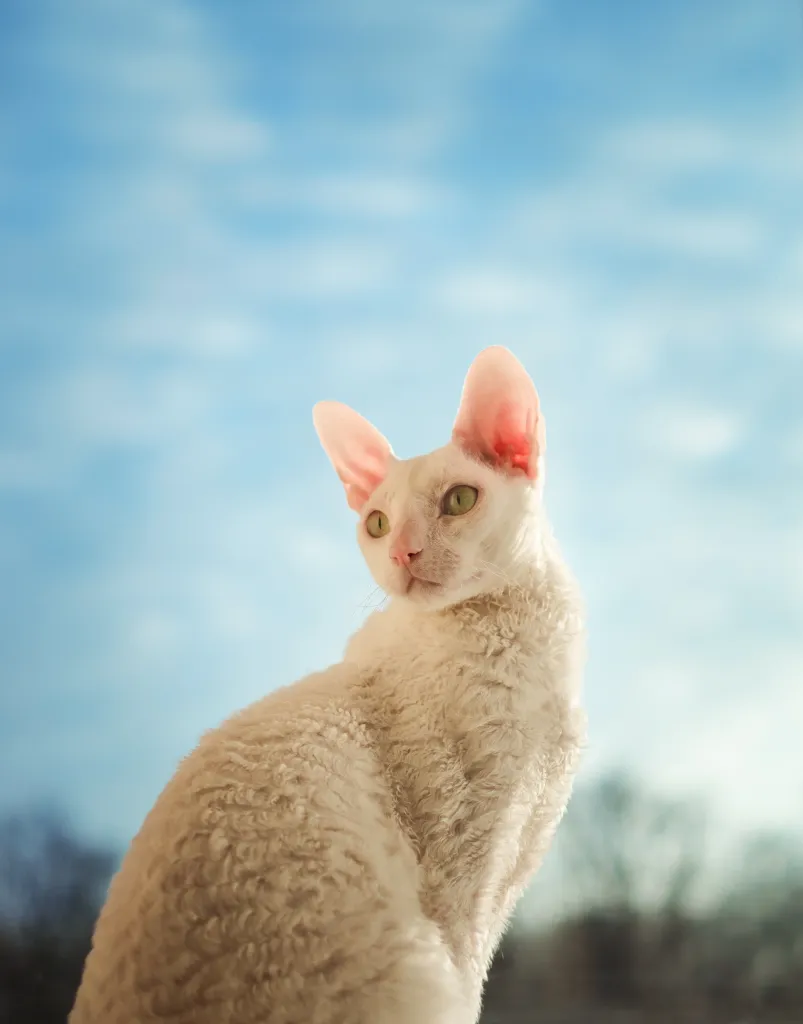The Cornish Rex cat, with their striking appearance and unique characteristics, is a captivating breed that has captured the hearts of cat lovers worldwide. These elegant felines have a wavy coat that is soft and fine, resembling crushed velvet. Additionally, their large ears and inquisitive nature set them apart in the world of domestic cats.
This beloved breed is somewhat hypoallergenic, making them a popular choice for those with cat allergies. The Cornish Rex is also known for their playful and active nature. Their acrobatic abilities and love of climbing earn them the description of “cat-like monkeys.” They are highly sociable and enjoy being the center of attention, making them great companions. Whether you’re drawn to their striking appearance or their engaging nature, Cornish Rex cats make wonderful and entertaining companions for those who are willing to give them the love and attention they deserve.
When considering a Cornish Rex, it’s advisable to prioritize adopting from rescue organizations or shelters to provide a loving home to a cat in need. However, if you decide to purchase a Cornish Rex kitten, it’s crucial to choose a reputable breeder. Conduct thorough research to ensure that the breeder follows ethical practices and prioritizes the well-being of their cats. Reputable Cornish Rex breeders prioritize the health and temperament of their cats, conduct necessary health screenings, and provide a nurturing environment for the kitties. This active approach ensures that you bring home a healthy and happy kitty while discouraging unethical breeding practices.
Quick Facts
- Origin: England
- Size: Medium
- Breed group: Natural
- Lifespan: 12-15 years
- Coat: Short, wavy, and soft, with a variety of colors and patterns. They aren’t completely hypoallergenic.
- Temperament: Playful, affectionate, and intelligent
- Exercise needs: Moderate
- Training: Trainable
- Grooming: Low-maintenance
- Health: Generally healthy, but prone to certain health conditions, such as hip dysplasia and hypertrophic cardiomyopathy (HCM)
- In the 1989 film “Ghostbusters II”, Dr. Peter Venkman (Bill Murray) is handed a Cornish Rex, and says, “weird.”
- The whiskers and eyebrows are also curly.
- Due to their appearance and agility, they are often called the Greyhounds of cats.
Cornish Rex Pictures






-
Affectionate with Family
Some cat breeds are typically independent and aloof, even if they’ve been raised by the same person since kittenhood; others bond closely to one person and are indifferent to everyone else; and some shower the whole family with affection. Breed isn’t the only factor that goes into affection levels; cats who were raised inside a home with people around feel more comfortable with humans and bond more easily.

See Cats Less Affectionate with Family -
Amount of Shedding
If you’re going to share your home with a cat, you’ll need to deal with some level of cat hair on your clothes and in your house. However, shedding does vary among the breeds. If you’re a neatnik, you’ll need to either pick a low-shedding breed or relax your standards. This furniture cover can make it easier to clean up cat hair and keep it off your sofa!
-
General Health
Due to poor breeding practices, some breeds are prone to certain genetic health problems. This doesn’t mean that every cat of that breed will develop those diseases; it just means that they’re at an increased risk. If you’re looking only for purebred cats or kittens, it’s a good idea to find out which genetic illnesses are common to the breed you’re interested in.
-
Potential for Playfulness
Some cats are perpetual kittens—full of energy and mischief—while others are more serious and sedate. Although a playful kitten sounds endearing, consider how many games of chase the mouse-toy you want to play each day, and whether you have kids or other animals who can stand in as playmates. A classic wand cat toy like this one is perfect for playful felines!
-
Tendency to Vocalize
Some breeds sound off more often than others with meows, yowls, and chattering. When choosing a breed, think about how the cat vocalizes and how often. If constant “conversation” drives you crazy, consider a kitty less likely to chat.
-
Kid-Friendly
Being tolerant of children, sturdy enough to handle the heavy-handed pets and hugs they can dish out, and having a nonchalant attitude toward running, screaming youngsters are all traits that make a kid-friendly cat. Our ratings are generalizations, and they’re not a guarantee of how any breed or individual cat will behave; cats from any breed can be good with children based on their past experiences and personality.
-
Friendly Toward Strangers
Stranger-friendly cats will greet guests with a curious glance or a playful approach; others are shy or indifferent, perhaps even hiding under furniture or skedaddling to another room. However, no matter what the breed, a cat who was exposed to lots of different types, ages, sizes, and shapes of people as a kitten will respond better to strangers as an adult.
-
Easy to Groom
Some breeds require very little in the way of grooming; others require regular brushing to stay clean and healthy. Consider whether you have the time and patience for a cat who needs daily brushing. You should definitely pick up this awesome de-shedding tool for cats of any hair length!
-
Intelligence
Some cat breeds are reputed to be smarter than others. But all cats, if deprived the mental stimulation they need, will make their own busy work. Interactive cat toys are a good way to give a cat a brain workout and keep them out of mischief. This scratcher cat toy can keep your smart kitty busy even when you’re not home!
-
Pet Friendly
Friendliness toward other household animals and friendliness toward humans are two completely different things. Some cats are more likely than others to be accepting of other pets in the home.
Cornish Rex History
Cornwall is a sort of magical corner of Great Britain. It was the birthplace of King Arthur, and it was the birthplace of one of the most unusual and interesting cat breeds in existence: the curly-coated Cornish Rex. A curly-coated kitten was born in 1950 to a shorthaired tortoiseshell and white pet cat named Serena, who belonged to Nina Ennismore and Winifred Macalister. The other four kittens in the litter had short hair, so Kallibunker, as he was named, stood out for his odd coat, the result of a spontaneous natural mutation.
As is so often the case, the father of the litter was unidentified, although he was suspected to be Ginger, a shorthaired red tabby who was Serena’s litter brother. After obtaining advice on how to establish the new trait, Ennismore attempted to produce more of the kittens, breeding them to each other and outcrossing to shorthaired cats. She was somewhat successful, breeding among others a cat named Poldhu and his daughter LaMorna Cove, both of whom contributed to the later development of the breed, which came to be called the Cornish Rex, after its birthplace and its coat type, similar in texture to that of rex rabbits.
LaMorna Cove had been exported to the United States, and her kittens—from a breeding with Poldhu before she made her journey across the pond—helped to establish the breed in the United States. Because of the lack of breeding stock, the cats in the U. S. were outcrossed to Siamese. A son of Poldhu, Sham Pain Chas, fathered a litter in Great Britain in 1960, keeping the breed alive in its homeland.
Also contributing to its survival was the birth of two curly-coated kittens in East Germany, who were determined to have a similar mutation that was compatible with that of the Cornish Rex. The American Cat Fanciers Association and the Canadian Cat Association recognized the Cornish Rex in 1963, followed by the Cat Fanciers Association in 1964. The breed is now recognized by all cat registries.
Cornish Rex Size
The Cornish Rex typically weighs 6 to 10 pounds.
Cornish Rex Personality
The Cornish Rex appears suave and refined, but then this charming and highly intelligent cat’s sense of humor and love of attention take over and he strolls onto center stage, ready to play the piano, perform tricks, or amaze onlookers with his ability to vault to the highest point in the room.
His long toes enable him to manipulate objects deftly and to open doors and cabinets with ease. Be sure you put away securely anything you don’t want him to have (and don’t let him see you doing it). This is a confident cat who loves people and will follow them around, waiting for any opportunity to sit in a lap or give a kiss. He enjoys being handled, making it easy to take him to the veterinarian or train him for therapy work.
If it weren’t insulting, it might be fair to describe the Cornish Rex as “doglike.” That includes his willingness to retrieve toys that are thrown. He has the speed of a sighthound but does not share the sighthound’s laidback temperament.
The Cornish Rex is highly active, always on the move. His speed and sleek exterior are reminiscent of a finely tuned racecar, complete with quick starts and cornering ability. Although he is affectionate and gentle, he is not the choice for someone who wants a quiet, ornamental cat. His voice ranges from sweet to strident, and although he is not as talkative as his ancestor the Siamese, he will indeed carry on a conversation if he feels the need to express his opinion.
The Cornish Rex maintains his kittenlike attitude well into old age. He never loses the desire to interact with people and is best suited to a home where he will receive the love and constant companionship he craves.
Cornish Rex Health
Both pedigreed cats and mixed-breed cats have varying incidences of health problems that may be genetic in nature. Cornish Rex are generally healthy, but the following diseases have been seen in the breed:
- Congenital Hypotrichosis: Otherwise known as hereditary baldness, this is a condition that is probably the result of an inherited recessive gene. The Cornish Rex naturally has a very fine coat, but those with less hair than normal for the breed are considered to be hypotricotic.
- Umbilical Hernia: This occurs when a defect in the abdominal wall—near the umbilicus, hence the name—allows part of the intestine or other abdominal organs to protrude through the abdominal wall. The last known report of umbilical hernias in the breed was from 1997. Umbilical hernias can also have non-genetic causes.
- Hypertrophic Cardiomyopathy: A form of heart disease that is inherited in some cat breeds such as the Maine Coon. Heritability has not been proven in the Cornish Rex.
Cornish Rex Care
Grooming the Cornish Rex is typically as easy as brushing your hand over his coat. Some Cornish Rex cats have a longer or woollier coat, however, and may need some help from a soft bristle brush or fine-tooth comb to keep their coat looking neat. Groom gently so you don’t break the delicate hairs. The best thing about a Cornish Rex coat is that the hairs are so fine that they aren’t very noticeable on clothing and furniture.
Baths are rarely necessary unless the cat is white or has a lot of white on the coat. Those cats can start to look dingy if they are not regularly bathed. Brush the teeth to prevent periodontal disease. Daily dental hygiene is best, but weekly brushing is better than nothing. Wipe the corners of the eyes daily with a soft, damp cloth to remove any discharge. Use a separate area of the cloth for each eye so you don’t run the risk of spreading any infection.
Check the ears weekly. If they look dirty, wipe them out with a cotton ball or soft damp cloth moistened with a 50-50 mixture of cider vinegar and warm water. Avoid using cotton swabs, which can damage the interior of the ear.
Keep the litter box spotlessly clean. Like all cats, Cornish Rex are very particular about bathroom hygiene. The Cornish Rex feels warm to the touch, but he is always seeking warmth. If you are cold, he probably is too. Buy him a nice sweater or two to help him retain heat.
It’s a good idea to keep a Cornish Rex as an indoor-only cat to protect him from diseases spread by other cats, attacks by dogs or coyotes, and the other dangers that face cats who go outdoors, such as being hit by a car. Cornish Rex who go outdoors also run the risk of being stolen by someone who would like to have such an unusual cat without paying for it. If possible, build your Cornish Rex a large outdoor enclosure where he can jump and climb safely. If your Cornish Rex has an outdoor enclosure that allows for sunbathing, be sure to apply cat-safe sunscreen to his body to prevent sunburn.
Cornish Rex Coat Color And Grooming
With his crushed velvet coat, racy, slender body, and curly whiskers, the Cornish Rex is a dandy of a cat. In addition to his soft, wavy fur and curvy body, he is distinguished by a small, egg-shaped head, about one-third longer than it is wide. His facial features include a rounded forehead, the high cheekbones of a supermodel, a Roman nose with a high, prominent bridge, and oval eyes that slant slightly upward. Sitting high on the head are large ears that look as if they could pull in satellite signals.
The distinctive body, a gift from the Cornish Rex’s Siamese ancestors, is made up graceful arches and curves. It consists of a long, slender torso, a deep chest, a naturally arched back, and a belly that curves gently upward to form a small waistline. Muscular hips, thighs and rear end propel the Cornish Rex’s great leaps. Supporting him when he lands are long, slender legs and dainty, slightly oval paws. A long, flexible tail tapers toward the end. His curvy, slender body might make the medium-size Cornish Rex seem delicate, but he is surprisingly heavy when picked up. He typically weighs 6 to 10 pounds.
The Cornish Rex curls are present at birth. Some kittens go through a stage during which the coat is flat and suedelike, but as they mature the coat becomes wavy again. At adulthood, usually between 18 months and three years, the coat is short, soft and silky, with no harsh guard hairs. The fur lies close to the body in tight waves, like the marcelled hairdo of a 1940s film star. It should not be sparse or bare in places.
The coat comes in a profusion of colors and patterns. Solid colors are white, black, blue, red, cream, chocolate and lavender. They also come in various tabby colors and patterns, tortoiseshell, calico, bi-color and pointed patterns, to name just a few. Depending on the coat color, the eyes may be gold, green or hazel.
Children And Other Pets
The active and social Cornish Rex is a perfect choice for families with children and cat-friendly dogs. He will play fetch as well as any retriever, learns tricks easily and loves the attention he receives from children who treat him politely and with respect. Introduce pets slowly and in controlled circumstances to ensure that they learn to get along together.
Cornish Rex Rescue Groups
More Info For You
If you’re also looking for a dog, check out DogTime.com’s dog breed page!





